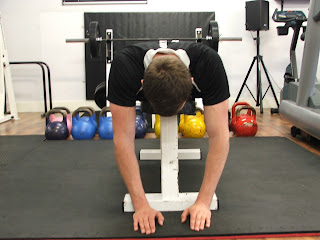Exercise selection
When it comes to strength and conditioning for triathlon it is simple to fall into the old body building programmes which is how most sports fell into developing their own programmes and protocols
The demands of the sport are vast and too time consuming to go into each particular bio mechanical demand, stress and requirement of each muscle group, however once you understand the basic requirements of the muscles, exercise prescription and selection should be easy for you.
Firstly we will start from the ground up and look at exercises to increase overall strength in each of the disciplines.
In this article we will look at two types of squat although all squats have unique coaching points to each of them, the basic fundamentals in general are the same
> each squat movement should be initiated with the hips sitting backwards (imagine sitting in a chair) your knees will bend automatically, your back should be kept tight with the abdominals in a braced position, the back must not be allowed to round off at any point, if your lower back rounds a few factors need to be looked at the first and main two are technique and the weight lifted.
> knees must be stable (the knee is a stabilising joint (so allow it to do its job) the knees should not be falling inwards they should follow the line of your toes.
> the descent must be controlled with a slight pause or hold on completion of the downward movement, this allows for a more powerful drive after the initial inertia has stopped. Never bounce out of the squat!
> Your weight must be evenly distributed throughout the exercise your feet should be about shoulder width apart
Exercise 1 Front Squat
The front squat is probably the second least used squat after the overhead owing to a greater degree of difficulty compared with the back squat, the front squat also allows for a bit of variety in your session.
As stated this squat is technical and the biggest obstacle for many people is holding the bar in the correct position.
The bar can be held in the crossed arm position (fig 1) or the clean position (fig 2)
Cross arm position

Flex the elbows and cross your forearms in front of your chest Position the bar evenly on top of the anterior deltoid without use of your hands Place your hands on top of the bar using the fingers (hand open palm down) to keep it in position.
Move the arms upwards so they are parallel to the floor.
Clean position

many struggle with this position owing to a combination of lat and wrist tightness.
Grab the bar with an even closed pronated grip ensuring the hands are just over shoulder width apart Rotate the bar so it rests on the anterior deltoids or clavicles, the hands should be just out with the shoulders with the back of the hands resting on the deltoid or clavicle.
We advocate position 2 as this will be of greater assistance later in the programmes when completing the Clean and Press
Exercise 2
Back Squat
The most commonly used squat and one that probably promotes more incorrect technique than correct technique, mainly owing to the use of a Sissy pad.
Sissy pads promote in correct technique by allowing users to rest the bar using the pad on their shoulders thus promoting incorrect technique by not allowing the user to retract the shoulders making the chest bigger and allowing the back to naturally produce a bed of muscle for the bar to sit on comfortably. if the pad is used it can promote bad posture issues and a loose upper back.
The back squat has two placement positions which is personal to the user dependant on any factors however both are correct and both can be used. All users should regularly attempt to to use both positions in their programme.
Low back position

Grasp the bar and place it across the shoulders in the middle of the trapezius and across the posterior deltoids ensuring the bar is in an even position ensure the grip is closed and pronated and outside shoulder width apart
High Back position

Grasp the bar and place it above the posterior deltoids just below the neck closed pronated grip with hands outside shoulder width apart.
NB for both of the positions the elbows should be raised to promote a shelf with the upper back and shoulders this prevents the bar from slipping.




